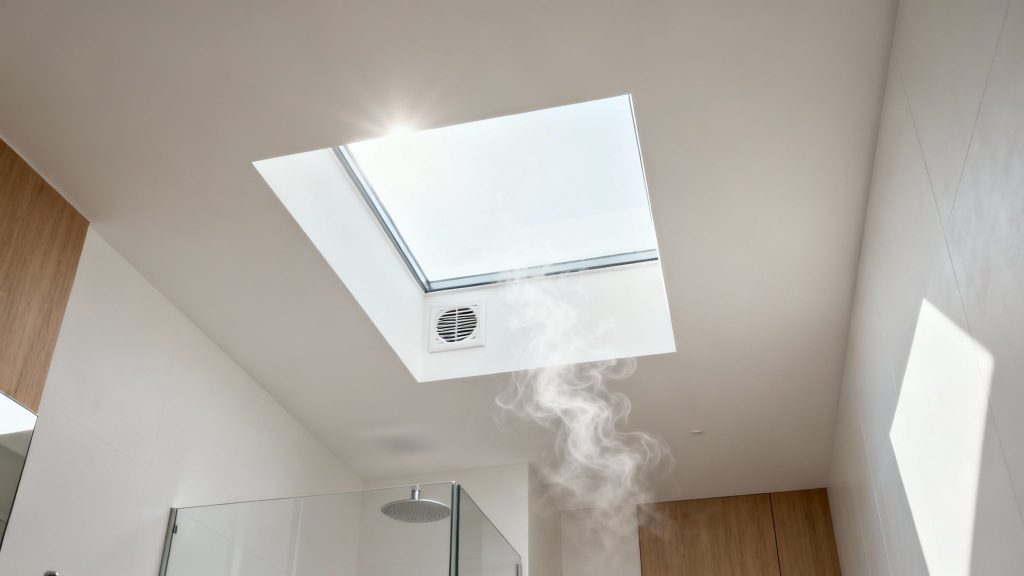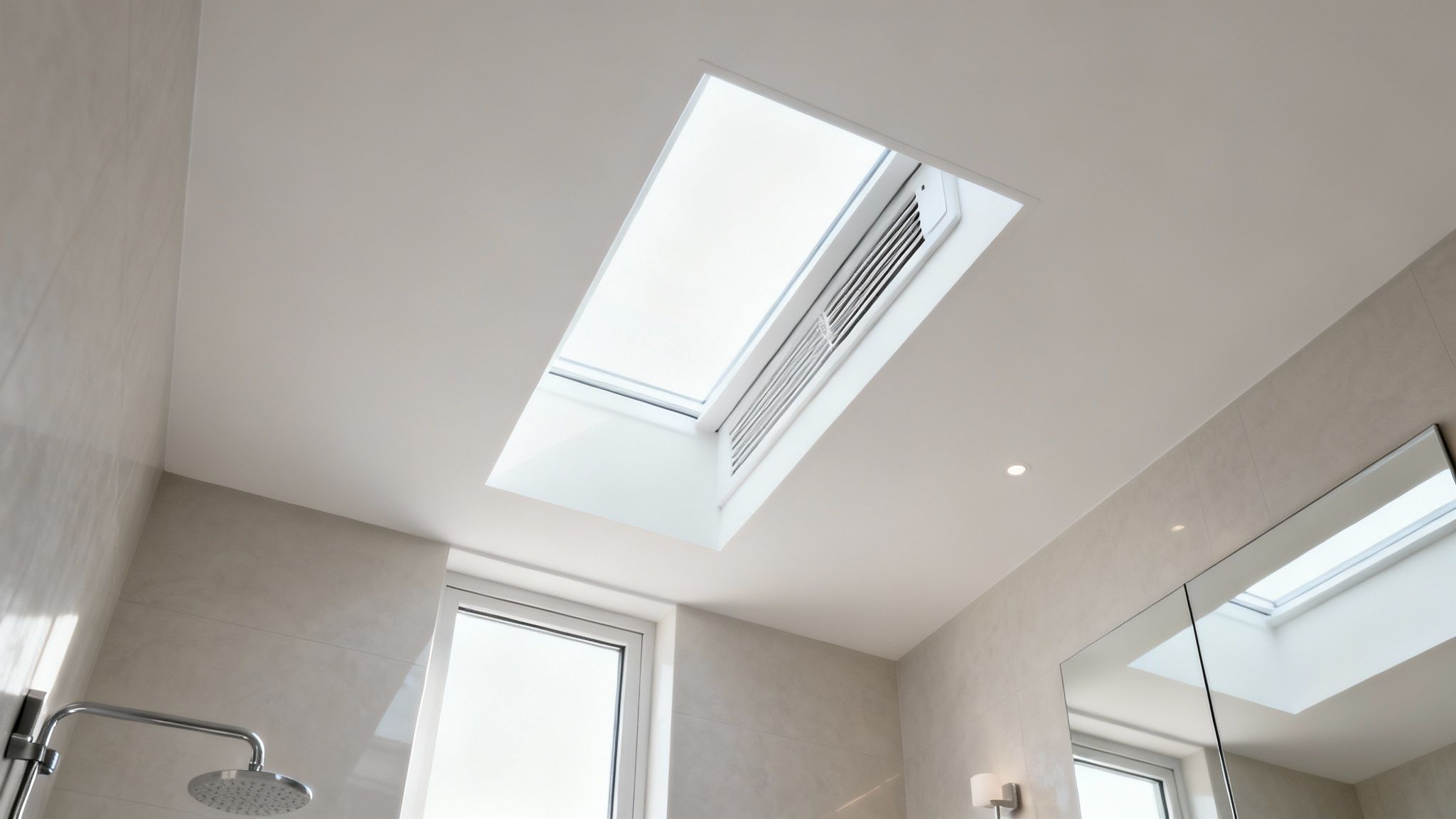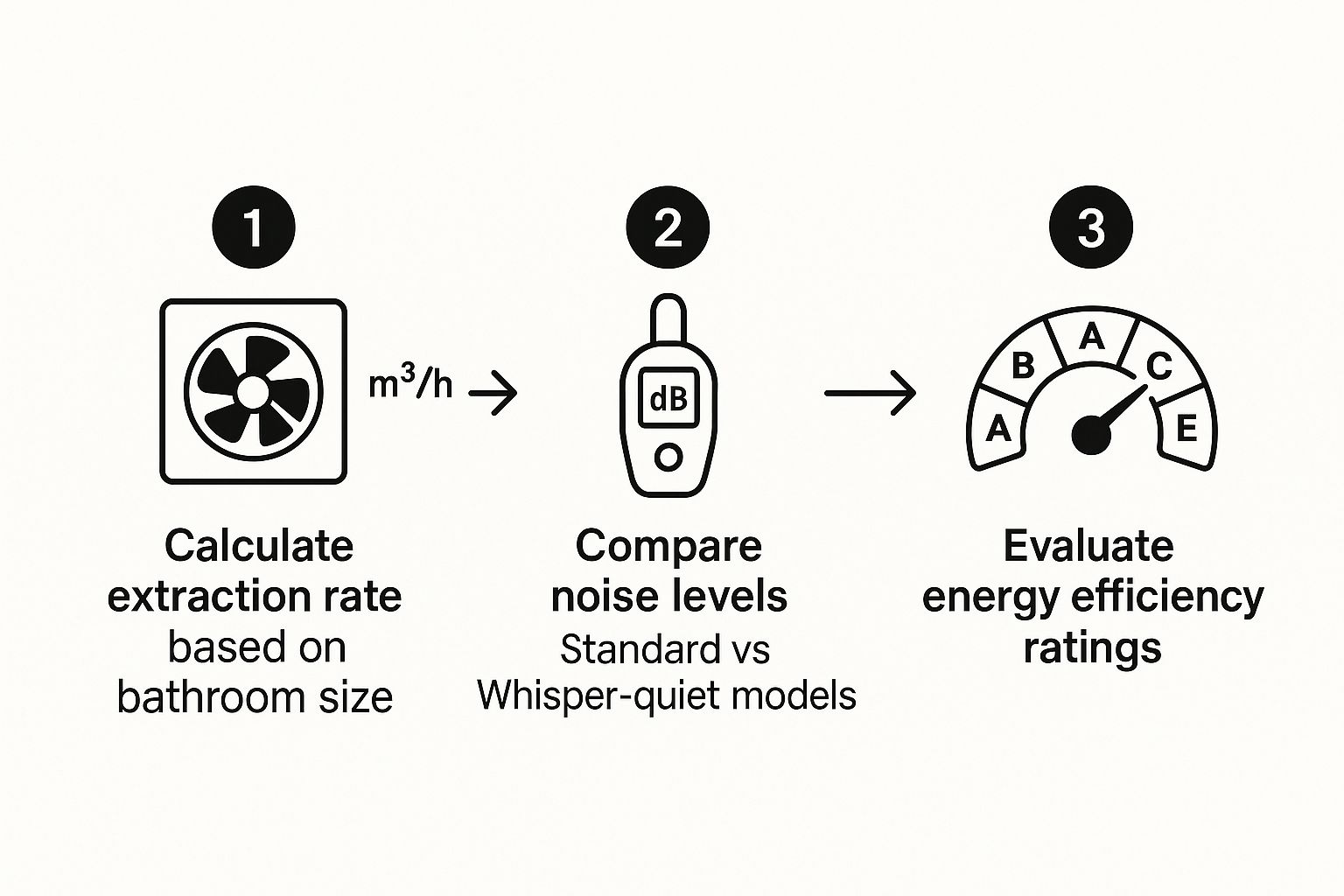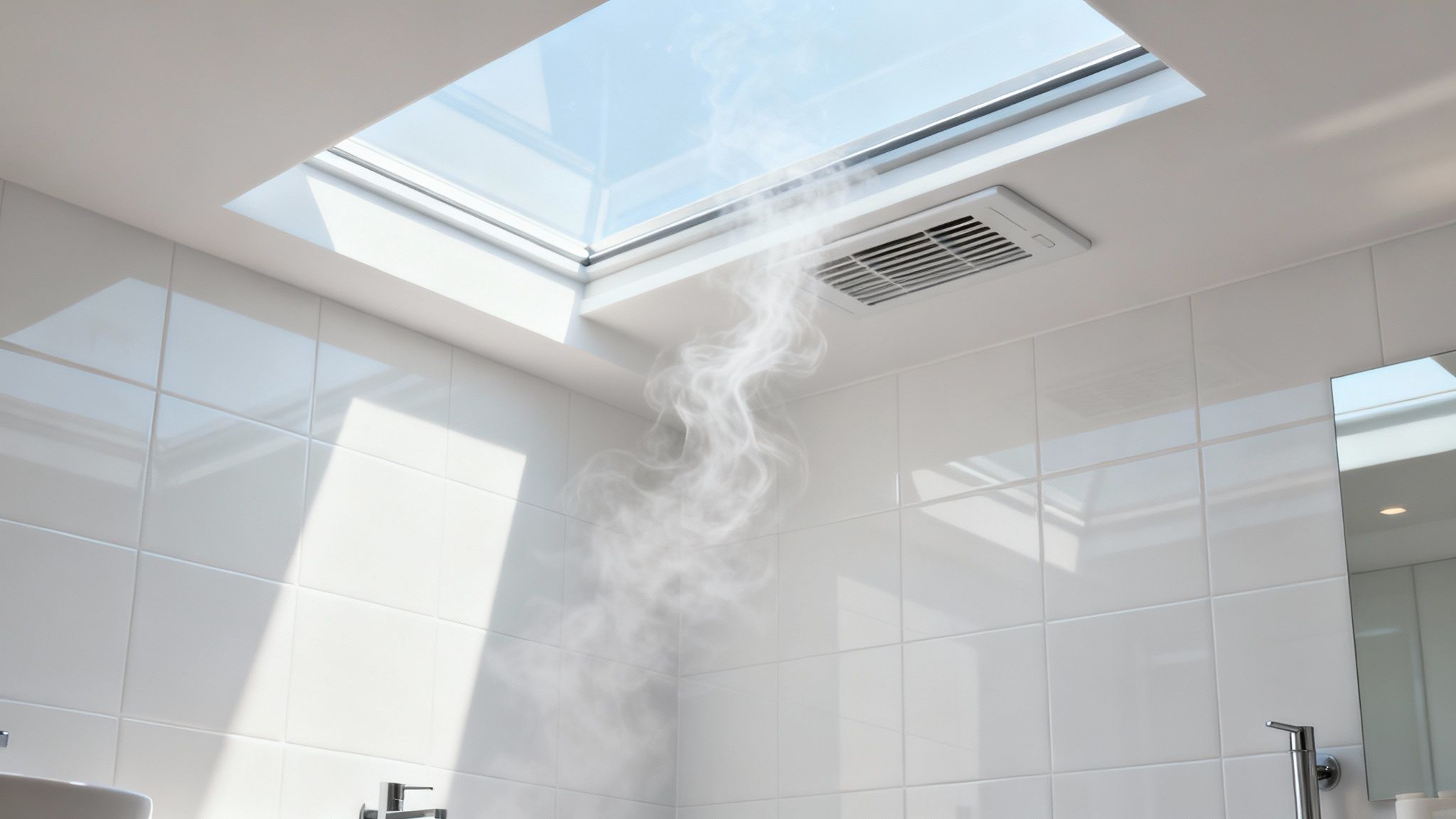 A skylight exhaust fan is a seriously clever ventilation solution where the fan is installed directly inside the skylight shaft, rather than taking up space on your ceiling. This integrated setup offers superior moisture extraction and creates a much cleaner, more minimalist look by completely hiding the fan from view. It’s an ideal choice for bathrooms and ensuites where you want both beautiful natural light and seriously effective ventilation.
A skylight exhaust fan is a seriously clever ventilation solution where the fan is installed directly inside the skylight shaft, rather than taking up space on your ceiling. This integrated setup offers superior moisture extraction and creates a much cleaner, more minimalist look by completely hiding the fan from view. It’s an ideal choice for bathrooms and ensuites where you want both beautiful natural light and seriously effective ventilation.
Why Hide Your Fan in a Skylight Shaft?
Picture a bathroom ceiling that’s clean, uncluttered, and flooded with gorgeous natural light. The secret isn’t getting rid of the essential exhaust fan—it’s cleverly hiding it. When installing a Vivid Skylight in an ensuite or bathroom, a great idea for effective ventilation is to install your exhaust fan in the skylight shaft. There are two key benefits to doing this: firstly, steam can be extracted more effectively in this position, and secondly, you can hide your exhaust fan from view, allowing more space for lighting options.

This integrated approach is fast becoming a go-to for savvy renovators, especially in design-conscious areas like Armadale, who understand that great design solves practical problems beautifully. The core idea is simple: merge two essential household features into one seamless, high-performing system.
Unlocking Superior Ventilation Performance
The first major win is a dramatic improvement in ventilation efficiency. When you take a hot shower, all that steam naturally rises. A standard ceiling-mounted fan might be positioned metres away, which allows moisture to spread and settle on your walls and mirrors long before it gets extracted.
Placing the exhaust fan directly in the skylight shaft puts it at the highest point in the room—exactly where steam and humid air gather. This strategic placement lets the fan capture moisture right at the source, pulling it out of the room far more effectively. This proactive approach significantly cuts down the risk of:
- Pesky condensation on windows and walls.
- The growth of mould and mildew in grout lines and corners.
- Peeling paint or long-term water damage to your cabinetry.
By extracting steam more effectively, you’re not just clearing the air; you are actively protecting your bathroom’s finishes and structure from the damaging effects of excess moisture.
Creating a Clean, Uncluttered Ceiling
The second benefit is purely aesthetic, but it makes a huge difference. A traditional exhaust fan, often just a plastic grille, can really disrupt the clean lines of a modern bathroom ceiling. It takes up valuable visual real estate and can cramp your design style.
By hiding the fan inside the skylight shaft, you reclaim that ceiling space entirely. This allows for a much more streamlined and sophisticated look. You free up prime locations for other features, like elegant pendant lights, downlights, or even a statement chandelier, without having to work around a clunky fan unit.
For homeowners thinking about a skylight with ventilation, this combination truly offers the best of both worlds—unobstructed natural light and powerful, completely unseen air extraction.
Choosing the Right Skylight Exhaust Fan
Picking the right fan is about more than just what it looks like; it’s a decision that will affect your home’s comfort and air quality for years to come. When you’re installing a Vivid Skylight in an ensuite or bathroom, a properly chosen skylight exhaust fan is the key to making the whole system work perfectly. Let’s walk through the technical bits and pieces that really matter.
A fan’s main job is to move air, and we measure its power in cubic metres per hour (m³/h). One of the most common mistakes people make is choosing a fan that’s too weak for their bathroom. If the extraction rate is too low, it just swirls steamy air around instead of pulling it out, which is a fast track to condensation and mould problems.
This infographic breaks down the essential steps to finding the perfect fan for your space.

As you can see, the process is pretty straightforward: match the fan’s power to your room’s volume, think about how loud it is, and check its energy use to avoid surprises on your power bill.
Calculating the Correct Extraction Rate
To make sure your fan can actually handle the job, you’ll need to do a quick calculation. A good rule of thumb is to multiply your bathroom’s volume (Length x Width x Height in metres) by the number of times you want the air replaced each hour. For bathrooms, you’re aiming for 15 to 20 air changes.
Let’s take a typical bathroom that’s 2.5m long, 3m wide, with a 2.4m ceiling. The total volume is 18 cubic metres.
- Calculation: 18 m³ x 15 air changes/hour = 270 m³/h
This tells you to look for a fan with an extraction rate of at least 270 m³/h. Getting this right is crucial, and having a solid grasp of understanding air changes per hour is fundamental to ensuring your space is properly ventilated.
Noise Levels and Key Features
Once you’ve figured out the power you need, the next big thing to consider is noise. A loud, rattling fan can completely ruin the peaceful vibe of a bathroom. Fan noise is measured in decibels (dB), and for a quiet experience, you should be looking for something rated below 40 dB.
Whisper-quiet inline models are fantastic for this. The motor sits up in the roof space, not directly over your head, which makes a massive difference to the noise level inside the room.
Beyond just the sound, there are a couple of other critical features to look for. Here’s a quick comparison of what to keep an eye on when you’re shopping around.
Exhaust Fan Feature Comparison
This table breaks down the essential features to look for, what they do, and why they’re important for your home.
| Feature | What to Look For | Why It Matters |
|---|---|---|
| Backdraft Damper | A built-in flap or shutter that closes when the fan is off. | This is a non-negotiable. It stops cold drafts, dust, and pests from getting into your bathroom from the outside. |
| Energy Efficiency | A low wattage (W) rating on the packaging or product specifications. | A lower wattage means the fan uses less electricity, saving you money on your power bills over its lifetime. |
| Motor Type | Look for ball-bearing motors. They are generally quieter and last longer. | A quality motor means better durability and less noise. It’s the difference between a fan that lasts years and one that fails quickly. |
| IP Rating | An IPX4 rating or higher, especially for installation directly over a shower or bath. | This rating indicates its resistance to water splashes, which is a critical safety feature for wet areas. |
Picking a fan with these features ensures it will be quiet, efficient, and safe for years to come.
Speaking of efficiency, if you’re looking for bigger energy-saving solutions for your whole roof, it’s worth exploring options like solar roof ventilation fans which can provide even greater benefits.
There’s a growing demand for these quiet, efficient models. In fact, the Australian exhaust fan market was valued at around USD 66.67 million in 2024 and is expected to hit USD 112.73 million by 2033, largely because homeowners are sick of noisy fans.
Your Practical Guide to Installing the Fan
Alright, let’s get into the nitty-gritty of the installation. This isn’t just a dry list of instructions; it’s a real-world guide packed with tips I’ve picked up over years of doing this. A proper installation is what turns a good fan and a quality Vivid Skylight into a ventilation powerhouse that protects your home for the long haul.
Whether you’re planning to tackle this yourself or want to have a smart conversation with your tradie, this guide has you covered. We’ll walk through prepping the skylight shaft, mounting the fan so it actually works well, and running the ducting like a pro.
Prepping the Skylight Shaft
First things first, before any gear goes in, the skylight shaft itself needs a bit of attention. This cavity is going to house the fan and ducting, so it needs to be clean, clear, and structurally solid.
If you’re doing a new build or a major reno in places like Armadale, this part is a piece of cake. The shaft is built from scratch with the fan system in mind.
For a retrofit, you’ll need to play detective. Pop your head in and inspect the existing shaft. Look for any stray nails, old forgotten wiring, or general building debris that could get in the way or, worse, tear the ducting. It’s also the perfect time to check that the shaft’s interior is properly sealed and insulated. This simple check helps stop energy loss and prevents condensation from building up inside the wall or ceiling cavity.
Mounting the Inline Fan Securely
The inline fan is the heart of this whole system, and where you put it makes a massive difference to its performance. The aim is to position it for maximum airflow while keeping noise and vibration to an absolute minimum.
Key Mounting Considerations
- Position for Power: The sweet spot is usually about midway up the skylight shaft. This gets it high enough to efficiently capture rising steam from the bathroom below, but not so close to the ceiling grille that it’s noisy.
- Dampen the Vibration: This is a big one. Never mount the fan directly onto the timber framing. If you do, the motor’s vibration will travel right through the structure, creating a constant, annoying hum inside your home. Always use rubber mounting brackets or suspension straps to isolate the fan from the frame.
- Think About Future Access: It might be out of sight, but don’t make it impossible to get to. Make sure you can still access the fan for a clean or service down the track without needing to rip apart the whole shaft. A little bit of planning here will save you a world of pain later.
Pro Tip: If you can, position the fan so it’s easy to get to from the attic or roof space. It makes future maintenance checks a hundred times easier than trying to work from inside the bathroom.
Running Ducting for Peak Performance
The ducting is the superhighway for all that moist, stale air you want to get rid of. Using the right stuff and installing it correctly is absolutely critical for maintaining strong airflow.
If you can, steer clear of that flimsy, flexible foil ducting. It’s notorious for kinking and tearing, which kills your fan’s efficiency by restricting airflow. A much better option is semi-rigid or even rigid ducting, which gives the air a smooth, clear path to the outside.
When you’re running the ductwork, remember these rules:
- Short and Straight: The best path is always the shortest and straightest one you can manage, from the fan right out to the exterior vent (like a roof cowl or eave vent).
- Minimise Bends: Every bend you add creates resistance and slows the air down. Try to stick to no more than two gentle, sweeping bends if you absolutely can’t avoid them.
- Seal Every Single Connection: This is the step everyone seems to skip, and it’s so important. Use a quality foil tape or mastic sealant on every join—where the duct hits the fan, the ceiling grille, and the exterior vent. Airtight seals stop your precious heated or cooled air from leaking into the roof cavity, which saves you money and stops moisture from condensing where it shouldn’t.
The Critical Role of a Licensed Electrician
I can’t stress this enough: all electrical wiring for your skylight exhaust fan must be done by a licensed electrician. This is not a weekend DIY job. It’s about safety, it’s about complying with Australian standards, and it’s about making sure your home insurance is actually valid if something goes wrong.
A sparky will:
- Safely run the power to the fan’s location.
- Install the correct switch in your bathroom.
- Ensure every connection is secure, waterproof, and up to code.
Trying to do your own electrical work is not only illegal but incredibly dangerous. Get a professional to handle this final, crucial part of the job. It’s the only way to guarantee the system is safe and works perfectly from day one.
Juggling Natural Light and Better Airflow
A skylight exhaust fan isn’t just a fan slapped onto a window; it’s a smart, integrated system built for the way we live today. This combination gets right to the heart of a common problem for Aussie homeowners: moisture. By tackling it head-on, you’re preventing the mould and gradual decay that can cause so much stress and damage. It’s a perfect example of how clever design makes your home work better and feel better.

When you pair a quiet, powerful fan with a quality skylight from a specialist like Vivid Skylights, the result is a space that feels bigger, brighter, and more welcoming. You get all that glorious natural light pouring in, while the fan works silently behind the scenes to keep the air fresh and healthy.
Creating a Healthier Home
The biggest win here is how the system deals with humidity before it becomes a problem. All that steam from hot showers is a major cause of mould, which can be a nightmare for anyone with allergies or respiratory issues. By placing a skylight exhaust fan directly over the shower, you’re pulling that steam out before it has a chance to fog up mirrors and settle on your walls and ceiling.
This immediate extraction is what keeps your bathroom healthier and protects your investment in the long run. It stops paint from peeling, wallpaper from bubbling, and that beautiful timber vanity from warping over time.
Think of it this way: you’re not just clearing a foggy mirror. You’re actively protecting your home’s air quality and structure for years to come. It’s a smart, preventative step that adds real value.
Boosting Ambiance and Aesthetics
Beyond the practical health benefits, this setup completely changes the feel of a room. Natural light is a well-known mood-booster, turning a purely functional bathroom into something that feels more like a relaxing retreat.
Tucking the fan away inside the skylight shaft also means you get rid of the ugly plastic fan grille on your ceiling. This gives you a clean, minimalist look and opens up your design options—a huge plus for homeowners in areas like Armadale who appreciate both style and substance. You can make a feature of your lighting or just enjoy the simple, uninterrupted ceiling.
It’s clear that Aussies are catching on to the importance of good air quality. The Australian ventilation fan market was worth USD 34.8 million in 2023 and is expected to hit USD 70.5 million by 2030, which shows just how much we’re prioritising healthier homes.
And while a skylight exhaust fan is brilliant for day-to-day ventilation, sometimes you need a more heavy-duty solution. For homes dealing with significant allergens or airborne nasties, it’s worth looking into other strategies for cleaner indoor air to really round out your system.
Keeping Your Skylight Exhaust Fan in Top Shape
You’ve got your new skylight exhaust fan installed and it’s already making a world of difference. That’s fantastic. But the job isn’t quite done just yet. To make sure it keeps running smoothly for years to come, a little bit of maintenance goes a very long way. Think of it as a simple care plan to protect your investment and keep your bathroom feeling fresh and healthy.
Without regular upkeep, dust and grime can slowly build up, putting a strain on the fan motor and seriously reducing its airflow. A clean system isn’t just about better performance—it’s about longevity.
Your Simple Maintenance Checklist
Keeping your system humming along is surprisingly straightforward. Just set aside a bit of time every six months or so to run through these simple checks. Before you start anything, though, always switch off the power to the fan at your circuit breaker. Safety first.
- Clean the Grille and Fan Blades: Pop off the ceiling grille and give it a good wipe with a damp cloth. If you can safely get to the fan blades inside the shaft, use a cloth or a vacuum with a brush attachment to gently clear away any built-up dust.
- Inspect the Ductwork: When you’re next in the roof space, take a quick look at the ducting. You’re searching for any sagging sections, kinks, or tears that could be choking off the airflow. Make sure every connection is still sealed up tight to prevent leaks.
- Check the Exterior Vent: Head outside and check that the vent on your roof or eave is clear. It’s a prime spot for leaves, twigs, and even the occasional bird’s nest to cause a blockage. A clogged exit forces the fan to work way harder than it should.
This routine also includes the skylight itself, of course. For tips on keeping the glass crystal clear to let in all that beautiful natural light, have a look at our detailed guide on how to clean skylights.
Spotting the Early Warning Signs
Most of the time, your fan will give you a heads-up when something isn’t quite right. Learning to spot these clues can help you sort out a small issue before it turns into a proper headache.
Listen for anything out of the ordinary. A sudden rattling, a grinding noise, or a new, loud humming is a clear sign that the fan’s motor or bearings might need some attention. Don’t just ignore it and hope it goes away—it’s always best to investigate sooner rather than later.
Another dead giveaway is a drop in performance. If your bathroom mirror is staying fogged up for much longer than it used to, the fan’s extraction power has probably taken a hit. This could be something as simple as a blockage, or it might point to an issue with the motor. Catching these signs early ensures your skylight exhaust fan can continue doing its crucial job of protecting your home from moisture damage.
Your Skylight Fan Questions Answered
We get it—putting an exhaust fan inside a skylight shaft is a brilliant concept, but it’s natural to have a few questions before diving in. Here are some quick, straightforward answers to the most common queries we hear from homeowners looking to make this clever ventilation solution a reality.
Is It a Hassle to Install a Fan in a Skylight Shaft?
While it’s a bit different from slapping a standard fan on the ceiling, it’s not necessarily more complicated—especially if you’re already renovating or building new. The job involves fitting an inline fan into the shaft and running some ducting. The real key is planning ahead.
For projects in areas like Armadale, where homeowners want that perfect blend of clean aesthetics and high performance, building a skylight exhaust fan into the initial renovation plans makes the whole process seamless. It’s definitely a job for a professional installer and a licensed electrician, but it’s a well-established and straightforward practice for them.
Will the Fan Make My Skylight Noisy?
This is probably the number one concern we hear, but the answer is a resounding no. In fact, it’s usually much, much quieter than your typical ceiling fan.
Think about it: a standard exhaust fan has the motor sitting right there in the room with you. With a skylight setup, we use an inline fan. The motor itself is mounted remotely, tucked away inside the shaft or even up in the roof cavity.
That separation is the secret to its whisper-quiet operation. All you’ll hear is the gentle whoosh of air moving, not the annoying mechanical drone of a motor.
Tucking your exhaust fan into the skylight shaft is a win-win. You get far more effective steam extraction right at the source, and you hide the fan from view completely. This leaves your ceiling looking cleaner and frees up space for better lighting designs.
Is This Kind of Ventilation Actually Effective?
Absolutely. It’s hands-down one of the most effective ways to ventilate a bathroom or laundry.
Steam and moisture naturally rise, so placing the extraction point at the very highest part of the ceiling—inside the skylight—captures that humid air right where it gathers. This stops moisture from spreading across the room and causing issues like mould. It’s a much smarter, more targeted approach than a fan placed randomly on a flat ceiling.
This kind of high-performance solution is driving major growth in the Australian residential ventilation market. The market was valued at around USD 682.5 million in 2024 and is on track to shoot past USD 1 billion by 2030. Homeowners are increasingly choosing smarter systems that genuinely improve indoor air quality, a trend you can read more about in recent industry research.
Ready to combine brilliant natural light with powerful, hidden ventilation? Explore what’s possible with Vivid Skylights and find the perfect solution for your home at https://vividskylights.com.au.
